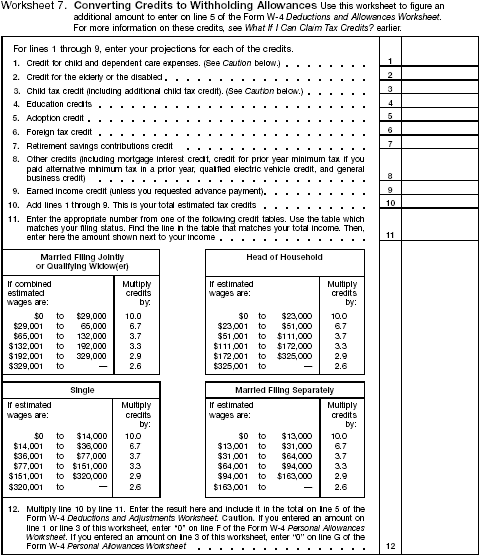Increasing Your Withholding
Post on: 16 Март, 2015 No Comment

Some people can avoid estimated tax payments by increasing their withholding.
You can use extra withholding on one type of income (such as wages) to avoid paying estimated tax on another type (such as interest, dividends or capital gain). And there’s a special benefit to this approach: extra withholding that comes late in the year is treated the same as if it was spread evenly over the year. You can use this approach to avoid late payment penalties.
Increasing your withholding
To increase the amount of federal income tax withheld from your paycheck, file a new Form W-4 with your employer. You’re required to fill out this form when you start working for an employer, and you can fill out a new one whenever your circumstances call for a change in the amount of withholding.
This form contains several worksheets, and the instructions tell you to complete all worksheets that apply. But the worksheets are there mainly to make sure you don’t reduce your withholding more than you’re supposed to. There’s never a problem when you want to increase your withholding. You can fill out the worksheets if you want, but you’re not required to do so. And there’s no particular need if the only thing you’re doing is increasing your withholding to cover tax on investment income.
There are two ways to increase your withholding on this form. One is to reduce the number of allowances you claim on the form. This can be a little tricky, because you don’t necessarily know how much your withholding will change when you change your allowances. The amount depends on your income level.
Some people are confused by allowances. You get one allowance for each exemption you can claim on your tax return (yourself, your spouse and your dependents), but an allowance isn’t the same as an exemption. There are allowances for other items (such as deductions and certain credits). Reducing your allowances doesn’t mean you’ll claim fewer exemptions when you file your tax return. The number of allowances is used only to determine how much income tax is withheld from your paycheck.
There’s another approach that’s simpler: request an additional amount to be withheld from your paycheck (line 6 of the form). This makes it fairly easy to determine the amount of the increase when you file Form W-4.
Check with your employer to find out when the change will go into effect. Normally there’s a time lag between the day you fill out this form and the day it’s processed, so you may not see the change in your very next paycheck. Keep an eye on your paycheck stubs to confirm that the change was properly made and had the effect you anticipated.
Avoiding late payment penalty
The nice thing about using withholding to cover your estimated tax liability is that it can get you out of a late payment penalty. Withholding is presumed to be received evenly throughout the year.
Example: Suppose you realize in May that you need to pay $6,000 estimated tax for the year, and you’ve already blown the first $1,500 payment that was due April 15. It won’t be a big deal if you send in the payment a few weeks late because the penalty is based on the amount of time the estimate was late (see Penalty for Underpayment ). But you can avoid the penalty altogether by increasing your withholding for the rest of the year by $6,000. The IRS will treat the withholding as if it occurred evenly throughout the year, with $1,500 coming in the first quarter.
Although the IRS is required to treat your withholding as if it came in evenly throughout the year, in appropriate circumstances you’re permitted to demonstrate that the opposite is true. For example, if you had lots of withholding during the first quarter of the year and smaller amounts later, you can take advantage of this fact to reduce a penalty that would otherwise apply in the first quarter.














